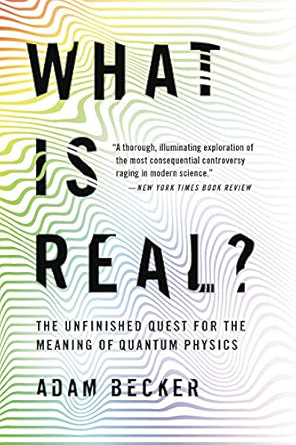More on this book
Community
Kindle Notes & Highlights
by
Adam Becker
Started reading
October 11, 2024
satisfied that it was adequate.
theory was conceptually incomplete,
wave function was not a complete description...
This highlight has been truncated due to consecutive passage length restrictions.
quantum physics, for all its successes, was stubbornly mute on the question of what was real.
existing and would stand by itself and did not always have to be referred to an observer,”
began to wonder, does [the wave function] give a complete description of reality?”
radically different from the Copenhagen interpretation.
In the meantime, Bohm had more good news. On May 31, he appeared in federal district court in Washington, DC, where he was cleared of all charges.
Princeton physics department announced that they would not be renewing Bohm’s contract,
Despite his legal innocence, Bohm remained on the blacklist.
found a job at the University of São Paulo, in Brazil.
there is nothing demonstrably illogical about the article, it really is just a philosophical point, of no practical interest.”
Bohm’s interpretation of quantum physics,
Objects have definite positions at all times, whether or not anyone is looking at them.
motions are guided by pilot waves.
Heisenberg’s uncertainty principle still holds—
simply a limitation on the information
that the quantum world is willing to yield to us.
Schrödinger’s cat
The act of observation has nothing to do with the condition of the cat.
how can it possibly hope to reproduce all the bizarre results of quantum physics?
guarantee is in the mathematics: Bohm’s theory is mathematically equivalent to the Schrödinger equation,
This is technically true, but it doesn’t
give a feel for how Bohm’s interpretation actually works.
great physicist Richard Feynman famously said that the double-slit experiment “has in it the heart of quantum mechanics,” and that “in reality, it contains the only mystery.”
weirdness really begins when you shine a much dimmer light on the double slit.
But photons aren’t really tennis balls of light, and they do something extraordinary instead: though each one hits the plate in a single location, their impacts collectively form an interference pattern on the plate (Figure 5.3b). Even though each photon went through
photons are deliberately messing with you.
What gives? How can the photons behave differently just because you’re watching them? How do they know you’re watching them at all?
photons can interfere with themselves as they pass through the double slit.
measuring the location of a photon forces it to behave as a particle:
asking where the photon was before the measurement is meaningless:
waves have no singular location.
account of how the quantum world behaves between measurements, is doomed to fail, because, as Bohr said, there is no quantum world.
strange results of the double-slit experiment
he gave a detailed account of what happens in the quantum world whether or not anyone is looking.
pilot wave passes through both and interferes with itself.
Putting photon detectors on each slit affects each photon’s pilot wave—no matter how ingenious the design, any photon detector must alter a photon’s pilot wave, as ensured by Heisenberg’s uncertainty principle, which in Bohm’s interpretation places limits on how much measuring devices can avoid interfering with the things they attempt to measure.
Bohm’s account, although measurement can influence a particle’s motion, all particles have definite positions whether or not anyone is looking at them.
is a lot like de Broglie’s old interpretation,
key physical insight is the same:
But Bohm succeeded where de Broglie failed.
insisting that everything be treated in a quantum way—both the things being measured and the devices doing the measuring.
every object, big and small, is ultimately governed by the same set of quantum equations.
According to Bohr, one of the fundamental features of quantum physics was “the necessity of accounting for the functions of the measuring instruments in purely classical terms, excluding in principle any regard to the quantum.”
Bohr “was irritated rather than amused.”
instead, a theory about how we interfaced with the world of the extremely tiny, a pragmatic invention, a means for predicting the outcomes of experiments and nothing more.
simply to find “methods for ordering and surveying human experience.”
How can there be any important difference between two competing theories that make the same predictions?
difficult issues in the philosophy of science


